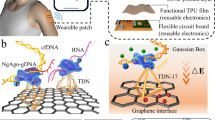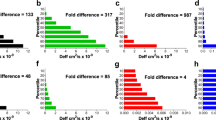Abstract
The alarming growth of the antibiotic-resistant superbugs methicillin-resistant Staphylococcus aureus (MRSA) and vancomycin-resistant Enterococcus (VRE) is driving the development of new technologies to investigate antibiotics and their modes of action. We report the label-free detection of vancomycin binding to bacterial cell wall precursor analogues (mucopeptides) on cantilever arrays, with 10 nM sensitivity and at clinically relevant concentrations in blood serum. Differential measurements have quantified binding constants for vancomycin-sensitive and vancomycin-resistant mucopeptide analogues. Moreover, by systematically modifying the mucopeptide density we gain new insights into the origin of surface stress. We propose that stress is a product of a local chemical binding factor and a geometrical factor describing the mechanical connectivity of regions activated by local binding in terms of a percolation process. Our findings place BioMEMS devices in a new class of percolative systems. The percolation concept will underpin the design of devices and coatings to significantly lower the drug detection limit and may also have an impact on our understanding of antibiotic drug action in bacteria.
This is a preview of subscription content, access via your institution
Access options
Subscribe to this journal
Receive 12 print issues and online access
$259.00 per year
only $21.58 per issue
Buy this article
- Purchase on Springer Link
- Instant access to full article PDF
Prices may be subject to local taxes which are calculated during checkout





Similar content being viewed by others
References
Fritz, J. et al. Translating biomolecular recognition into nanomechanics. Science 288, 316–318 (2000).
McKendry, R. A. et al. Multiple label-free biodetection and quantitative DNA-binding assays on a nanomechanical cantilever array. Proc. Natl Acad. Sci. USA 99, 9783–9788 (2002).
Savran, C. A., Knudsen, S. M., Ellington, A. D. & Manalis, S. R. Micromechanical detection of proteins using aptamer-based receptor molecules. Anal. Chem. 76, 3194–3198 (2004).
Calleja, M. et al. Highly sensitive polymer-based cantilever-sensors for DNA detection. Ultramicrosc. 105, 215–222 (2005).
Shu, W. et al. DNA molecular motor driven micromechanical cantilever arrays. J. Am. Chem. Soc. 127, 17054–17060 (2005).
Watari, M. et al. Investigating the molecular mechanisms of in-plane mechanochemistry on cantilever arrays. J. Am. Chem. Soc. 129, 601–609 (2007).
Backmann, N. et al. A label-free immunosensor array using single-chain antibody fragments. Proc. Natl Acad. Sci. USA 102, 14587–14592 (2005).
Zhang, J. et al. Rapid and label-free nanomechanical detection of biomarker transcripts in human RNA. Nature Nanotech. 1, 214–220 (2006).
Wu, G. et al. Bioassay of prostate-specific antigen (PSA) using microcantilevers. Nature Biotechnol. 19, 856–860 (2001).
Cooper, M. A. Advances in membrane receptor screening and analysis. J. Mol. Recognit. 17, 286–315 (2004).
Rao, J. et al. Binding of a dimeric derivative of vancomycin to L-Lys-D-Ala-D-Lactate in solution and at a surface. Chem. Biol. 121, 353–359 (1999).
Rao, J., Yan, L., Xu, B. & Whitesides, G. M. Using surface plasmon resonance to study the binding of vancomycin and its dimer to self-assembled monolayers presenting D-Ala-D-Ala. J. Am. Chem. Soc. 121, 2629–2630 (1999).
Cooper, M. A., Fiorini, M. T., Abell, C. & Williams, D. H. Binding of vancomycin group antibiotics to D-alanine and D-lactate presenting self-assembled monolayers. Bioorg. Med. Chem. 8, 2609–2616 (2000).
Vettiger, P. et al. Ultrahigh density, high-data-rate NEMS-based AFM data storage system. Microelec. Eng. 46, 11–14 (1999).
Despont, M., Drechsler, U., Yu, R., Pogge H. B. & Vettiger, P. Wafer-scale microdevice transfer/interconnect: Its application in an AFM-based data-storage system. J. MEMS 13, 895–901 (2004).
Williams, D. H. The glycopeptide story—How to kill the deadly ‘superbugs’. Nat. Prod. Rep. 13, 469–477 (1996).
Williams, D. H., Maguire, A. J., Tsuzuki, W. & Westwell, M. S. An analysis of the origins of a cooperative binding energy of dimerization. Science 280, 711–714 (1998).
Barna, J. C. & Williams, D. H. The structure and mode of action of glycopeptides antibiotics of the vancomycin group. Annu. Rev. Microbiol. 38, 339–357 (1984).
Kahne, D., Leimkuhler, C., Wei, L. & Walsh, C. Glycopeptide and lipoglycopeptide antibiotics. Chem. Rev. 105, 425–448 (2005).
Perkins, H. R. Specificity of combination between mucopeptide precursors and vancomycin or ristomycin. Biochem. J. 111, 195–205 (1969).
Nieto, M. & Perkins, H. R. Modifications of acyl-d-alanyl-d-alanine terminus affecting complex-formation with vancomycin. Biochem. J. 123, 773–787 (1971).
Mitchell, L. C. Changing patterns of infectious diseases. Nature 406, 762–767 (2000).
Walsh, C. Molecular mechanisms that confer antibacterial drug resistance. Nature 406, 775–781 (2000).
Neu, H. C. The crisis in antibiotic resistance. Science 257, 1064–1073 (1992).
Bugg, T. D. H. et al. Molecular-basis for vancomycin resistance in Enterococcus faecium BM4147—biosynthesis of a depsipeptide peptidoglycan precursor by vancomycin resistance proteins VanH and VanA. Biochemistry 30, 10408–10415 (1991).
Hopwood, D. A call to arms. Nature Rev. Drug Discov. 6, 8–12 (2007).
Ge, M. et al. Vancomycin derivatives that inhibit peptidoglycan biosynthesis without binding D-Ala-D-Ala. Science 284, 507–510 (1999).
Prime, K. L. & Whitesides, G. M. Self-assembled organic monolayers—model systems for studying adsorption of proteins at surfaces. Science 252, 1164–1167 (1991).
Prime, K. L. & Whitesides, G. M. Adsorption of proteins onto surfaces containing end-attached oligo(ethylene oxide)—a model system using self-assembled monolayers. J. Am. Chem. Soc. 115, 10714–10721 (1993).
Lahiri, J., Isaacs, L., Tien, J. & Whitesides, G. M. A strategy for the generation of surfaces presenting ligands for studies of binding based on an active ester as a common reactive intermediate: A surface plasmon resonance study. Anal. Chem. 71, 777–790 (1999).
Stoney, G. G. The tension of metallic films deposited by electrolysis. Proc. R. Soc. Lond. A 82, 172–175 (1909).
Brantley, W. A. Calculated elastic constants for stress problems associated with semiconductor devices. J. Appl. Phys. 44, 534–535 (1973).
Rotschafer, J. C. et al. Pharmacokinetics of vancomycin: Observations in 28 patients and dosage recommendations. Antimicrob. Agents Chemother. 22, 391–394 (1982).
Stauffer, D. & Aharony, A. Introduction to Percolation Theory 2nd edn (Taylor and Francis, 1991).
Benguigui, L. Experimental study of the elastic properties of a percolating system. Phys. Rev. Lett. 53, 2028–2030 (1984).
Sieradzki, K. & Li, R. Fracture behaviour of a solid with random porosity. Phys. Rev. Lett. 56, 2509–2512 (1986).
Sushko, M. L., Harding, J. H., Shluger, A. L., McKendry, R. A. & Watari, M. Physics of nanomechanical biosensing on cantilever arrays. Adv. Mater. (in the press).
Folkers, J. P., Hibinis, R. E. & Whitesides, G. M. Phase behaviour of two-component self- assembled monolayers of alkanethiolates on gold. J. Phys. Chem. 98, 563–571 (1994).
Smith, R. et al. Phase separation within a binary self-assembled monolayer on Au{111} driven by an amide-containing alkanethiol. J. Phys. Chem. B 105, 1119–1122 (2001).
Acknowledgements
We acknowledge funding from the Engineering and Physical Sciences Research Council (Speculative Engineering funding programme, J.W.N, R.McK., G.A., M.W., D.Z.), Interdisciplinary Research Centre in Nanotechnology (Cambridge, UCL and Bristol, M.W., J.W.N., R.McK.), the Royal Society (R.McK., J.W.N.), Biotechnology and Biological Science Research Council (R.McK.), the Wolfson Foundation (G.A.) and Cancer Research UK (A.D.B.). We thank E. Smith (University of Nottingham EPSRC XPS Open Access scheme) and J. and R. Galbraith (UCL Statistics) for helpful discussions.
Author information
Authors and Affiliations
Contributions
J.W.N. and M.W. contributed equally to this manuscript. All authors discussed the results and commented on the manuscript.
Corresponding author
Supplementary information
Supplementary Information
Supplementary Information (PDF 264 kb)
Rights and permissions
About this article
Cite this article
Ndieyira, J., Watari, M., Barrera, A. et al. Nanomechanical detection of antibiotic–mucopeptide binding in a model for superbug drug resistance. Nature Nanotech 3, 691–696 (2008). https://doi.org/10.1038/nnano.2008.275
Received:
Accepted:
Published:
Issue Date:
DOI: https://doi.org/10.1038/nnano.2008.275
This article is cited by
-
Vancomycin and curcumin-loaded zinc oxide functionalized chitosan carrier for the treatment of multi-drug resistant bacterial infection
Journal of Materials Science (2023)
-
Avoiding transduction-induced heating in suspended microchannel resonators using piezoelectricity
Microsystems & Nanoengineering (2021)
-
A CMOS MEMS-based Membrane-Bridge Nanomechanical Sensor for Small Molecule Detection
Scientific Reports (2020)
-
Conformational detection of heat shock protein through bio-interactions with microstructures
Research on Biomedical Engineering (2020)
-
Modified cantilever arrays improve sensitivity and reproducibility of nanomechanical sensing in living cells
Communications Biology (2018)



